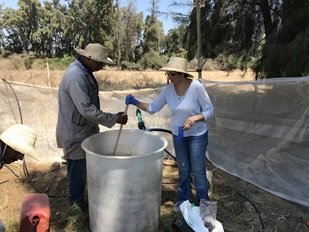|
Cycle 8 (2019 Deadline)
Evaluation of new citrus rootstocks for their adaptation in different growing environments in Tunisia
PI: Hajer Snoussi Ep. Trifa (hagersnoussi@gmail.com), National Institute of Agronomy Research of Tunisia
U.S. Partner: Violeta Tsolova, Florida A&M University (original partner: Anthony Ananga)
Project dates: March 2020 - March 2024
Project Overview
 | | The team collects samples in the field (photo courtesy of Dr. Snoussi). |
In Tunisia, the citrus sector is a strategic component of the overall national economic development program. Citrus production covers 27,000 hectares and is the main source of income for more than 12,000 farmers. Citrus fruits are among the most consumed fruits in Tunisia and constitute the most common and most affordable fruit in the Tunisian diet from September through May. Citrus production in the country is facing a complex combination of abiotic constraints like drought and salinity, as well as biotic threats such as Citrus Tristeza Virus (CTV). Citrus growing farmers would be poorly resilient in the case of a breakthrough of CTV, and potential risks are increasing given the current climate change trajectory. If this problem is not tackled, it would impact the entire citrus value chain, including producers, retailers, exporters, and consumers and would be a matter of food security as well. The most sustainable and environmentally friendly strategy is to promote combinations of a given commercial variety with a specific rootstock, conferring adaptation to the abiotic stresses and tolerance to CTV.
This PEER project applied morphological, physiological, and molecular analysis to various rootstock/cultivar combinations in multi-location field trials to gain a better understanding of the impact of the rootstock/cultivar relationship on physiological processes such as toxic ion uptake, ion translocation, ion homeostasis, water uptake, osmotic regulation, and photosynthesis resilience.
Commercial orchards usually contain more than one variety and/or citrus species. This is done because farmers often have to fulfill contracts to provide products over an extended period. In addition, this allows better management of the human resources at the farm, particularly for harvesting. Nurserymen are therefore called on to provide several location-specific rootstock/cultivar combinations in order to answer farmers’ demands. The project sought to offer farmers the best citrus combinations (rootstock/variety) to replace the current ones while ensuring the adaptation of these new combinations to local conditions to secure a good profit.
Final Summary of Project Activities
The researchers undertook serological analyses on 1,790 trees in Menzel Bouzelfa, 1,614 trees in ben Khalled, and 855 trees in Soliman (the most important citrus-growing regions), which showed a worsening contamination of CTV in these regions. They also assessed the agronomic performance of rootstock trials set up since 2017 in different production regions, including trials of four CTV-tolerant rootstocks (C. volkameriana, Citrumelo, Citrange carrizo, and Citrange C35), with the sour orange as the control, and three citrus varieties: two orange varieties (New Hall and Washington navel) and one mandarin variety (Hernandina). These trials showed a generalized superiority of C. volkameriana rootstock in all trial sites, between 16 and 33% depending on the site and variety for growth. Citrus volkameriana's superiority for cumulative yield is more evident with oranges, where it varies between 12% and 72%. Citrumelo swingle was the least efficient rootstock.
The PEER team undertook a study of the rootstock physiological responses to abiotic stresses, including soil and irrigation water analysis, symptomatic analysis of chlorosis related to salt stress leaf mineral status, and leaf chlorophyll content. They also studied orange by-products, including methanolic extracts from fruit pulp.
Finally, the team carried out surveys with farmers who had adopted new rootstocks and developed a database of characteristics of the surveyed farms, management variables, and farmers’ perceptions of CTV risks and experience in adopting tolerant rootstocks.
The PI and her colleagues organized a workshop on adoption of alternative rootstocks to sour oranges, in which they presented their findings and demonstrated the various alternative rootstocks and cultivation techniques. They also presented their findings at a seminar held at FAMU Viticulture Center during a visit to the U.S. partner in Florida. One of their impacts through connections with private industry is 80% of citrus nursery growers are currently producing plants on new rootstocks and the Tunisia state land office has authorized PEER continue surveying the extent of the disease's spread in its orchards in Cap Bon, and to collect data to assess its impact on the profitability of the activity and the value of adopting new rootstocks.
Back to PEER Cycle 8 Grant Recipients
|
|
|
|




